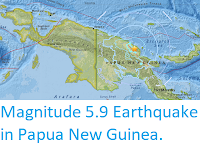Modern Humans are known to have occupied Papua New Guinea for at least 35 000 years, but archaeological remains older than about 2000 years are extremely rare, and therefore of great interest to Archaeologists. One such specimen is the Aitape Skull, a partial Human cranium found at Paniri Creek in the foothills of the Torricelli Mountains in 1929, and originally assessed to date from around the time of the first settlement of the island, due to the presence of Pleistocene Formaninferans in the sediments which produced it. For a long time this specimen was considered to be of great importance in understanding the origins of Human settlement in Australasia, but the introduction of Carbon-dating resulted in the age of the skull being lowered to about 6000 years, so that it was still one of the oldest Human specimens from Papua New Guinea, but was far too young to shed much light on the first Humans in the area, resulting in it being effectively forgotten by the archaeological community for many years.
In a paper published in the journal PLoS One on 25 October 2017, James Goff of the PANGEA Research Centre at the University of New South Wales and the Laboratoire Chrono-Environnement at the Université de Bourgogne-Franche-Comté, Mark Golitko of the Department of Anthropology at the University of Notre Dame, Ethan Cochrane of Anthropology at the University of Auckland, Darren Curnoe of the ARC Centre of Excellence for Australian Biodiversity and Heritage and the PANGEA Research Centre at the University of New South Wales, Shaun Williams of the National Institute of Water & Atmospheric Research in Christchurch, New Zealand, and John Terrell of the Integrative Research Center at the Field Museum of Natural History, report the results of a study which both re-examined the Aitape Skull and revisited the location where it was found.
The Aitape Skull was found at a site 12 km inland from Sissano Lagoon on the modern coast of Papua New Guinea, and about 52 m above modern sea-level. About 6000 years ago the sea-level was begging to stabilise, following a long period of rising waters. This would have created a stable coastal environment in the Paniri Creek region, with a system of lagoons and coastal lakes ideal for Human settlement. This has subsequently been uplifted by tectonic activity, pushing the modern coastline further to the north.
Site location and skeletal remains. (a) Location of New Guinea in the Pacific Ocean; (b) General study area in northern PNG (red square see (C)) with tectonic setting, CP: Caroline plate, MT: Melanesian trench, MTB: Mamberamo thrust belt, NBP: New Bismarck plate, NGT: New Guinea trench (arrows show approx. direction of plate movement); (c) Site of Aitape Skull where Paniri Creek exits the Barida Range approx. 11 km inland from Sissano Lagoon. Dashed orange line marks approx. edge of approx. 6000±7000 yr. old coastline; (d) Aitape cranium: The early Holocene Aitape frontal bone (scale bar at lower right is 2 cm). Goff et al. (2017).
The locality that produced the skull comprises chiefly laminated intertidal mudflat deposits; however the skull itself was found within a lenticular deposit which also contained coconut shell and fibre, driftwood, other plant remains, marine, intertidal and terrestrial shells and Foraminifera. This has previously been interpreted as a storm deposit, but Goff et al. reason that the presence of reworked Foraminifera indicates a more severe event, with substantial subtidal sediments excavated and dumped onto the beach. For this reason they believe the deposits are likely to have been produced by a tsunami, rather than a storm.
The north coast of Papua New Guinea is a tectonically active region, and tsunamis are not uncommon their. Notably a tsunami event which struck Sissano Lagoon in 1998 is known to have killed more than 2000 people, one of the moset severe tsunami events in recent years. They further note that the fragmentary nature of the Aitape Skull are not at odds with this. Most bodies recovered from tsunami events are relatively intact, but those associated with the 1998 Sissano Lagoon event were often dismembered to some degree, due to the high speeds at which the water hit settled areas.
Most tsunamis accumulate large amounts of sediment early in their progress, which tends to slow them down; for example the 2004 Indian Ocean tsunami hit beaches in India and Thailand at speeds of about 25 km per hour, while the 2011 event in the same region achieves slightly over 30 km per hour. The Sissano Lagoon tsunami appears to have been relatively free of sediments until it reached the lagoon itself, and is estimated to have been travelling at 65 km per hour 200 m from the beach, and was still travelling at over 40 km per hour 600 m inland. This enabled it to very rapidly accumulate large amounts of debris, including sediment, trees and parts of buildings, so that victims were dismembered by debris in a high energy impact.
See also...
Follow Sciency Thoughts on Facebook.







